News
Rafael Lozano-Hemmer media preview, MCA Sydney
Dec 16th
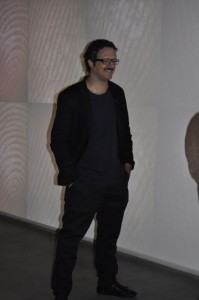 Ever get the feeling you’re being watched?
Ever get the feeling you’re being watched?
You certainly will at the MCA’s new exhibition, Recorders: Rafael Lozano-Hemmer. All of the one dozen works on show are tracking, measuring, surveillance and recording devices, writ large.
Artwriter attended the media preview of the exhibition this week, and took the photographs included in this post. The picture at left is Lozano-Hemmer.
I will upload my interview with Lozano-Hemmer soon. These pictures, however, will give some idea of the extraordinary artworks in the show.
Lozano-Hemmer was a personable, warm, and rather funny narrator of his own works.
Here, then, are some of my pictures.
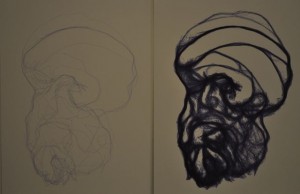 This is a detail of one element of a larger work titled Seismoscope.
This is a detail of one element of a larger work titled Seismoscope.
Seismoscope is a highly sensitive device which detects movement in the surrounding area, and records it by automatically drawing the face of a philosopher. Lozano-Hemmer can set it up to draw other things, as well. On days when there is little activity in the museum, Seismoscope draws a very light image. On days when the builders are working hard on the new MCA wing, and there are lots of vibrations, the image will be bolder and darker. You can see this effect in the image at left.
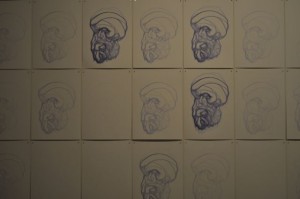 This is a wider angle view of the same thing.
This is a wider angle view of the same thing.
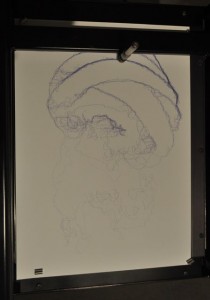
This is a close-up of that day’s drawing being drawn. You can see the pen at the top of the page. It is programmed to draw the philosopher’s face in bold, strong lines when there is a lot of vibration, or to produce a very light drawing if the surroundings are quiet and still.
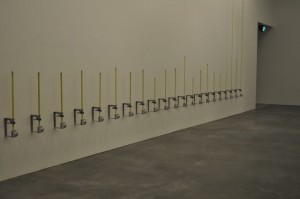 This mesmerising work, at left, is a line of measuring tapes which detect the presence of a viewer in front of them. When one of the tapes picks you up, the tape will continue to slowly grow until its full extent is realised and the top-heavy measuring tape crashes to the floor.
This mesmerising work, at left, is a line of measuring tapes which detect the presence of a viewer in front of them. When one of the tapes picks you up, the tape will continue to slowly grow until its full extent is realised and the top-heavy measuring tape crashes to the floor.
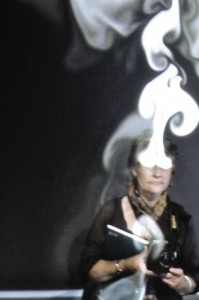 Artwriter testing a Lozano-Hemmer artwork called The Year’s Midnight.
Artwriter testing a Lozano-Hemmer artwork called The Year’s Midnight.
A camera is mounted above the mirror in which you see yourself. You look up into the small camera, and by using face-recognition technology, the work removes your eyes digitally and puts them at the bottom of the screen in the manner of St Lucy in Mexico. Smoke then emanates digitally from your eyeballs.
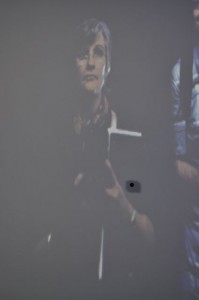 And here is Artwriter in a fascinating work called People on People. Once detected, you appear randomly on a huge screen. Ghost images of other visitors to have stood in front of the work appear of their own volition. Time slips. People who were recorded many months ago appear on the same screen beside people who have only just left their “impression” on the work.
And here is Artwriter in a fascinating work called People on People. Once detected, you appear randomly on a huge screen. Ghost images of other visitors to have stood in front of the work appear of their own volition. Time slips. People who were recorded many months ago appear on the same screen beside people who have only just left their “impression” on the work.
I will write my interview with Rafael Lozano-Hemmer and post it on these pages soon.
Elizabeth Fortescue, December 16, 2011
Picasso in Sydney: ArtWriter goes behind the scenes
Nov 13th
Picasso: Masterpieces from the Musee National Picasso, Paris, is on at the Art Gallery of NSW from this weekend.
Last week, I went behind the scenes to do a video for the Daily Telegraph on just how Sydney came to be seeing 150 works by such a great master as Pablo Picasso.
Elizabeth Fortescue
Picasso in Sydney as seen by ArtWriter using helmet cam!!!
Nov 13th
I did this video with editor Ian Perry for the Daily Telegraph. It was hysterically funny to do, because it involved going around the Picasso exhibition at the Art Gallery of NSW while wearing a Go Pro camera mounted on a helmet. Check it out. It will give you a rather quirky idea of what the new exhibition, which is on until March 2012, is like.
http://video.dailytelegraph.com.au/2166243087/Sydneys-Picasso-exhibition
Elizabeth Fortescue, November 13, 2011
Fiona Hall talks to ArtWriter about her Artist Award
Sep 21st
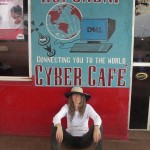
Fiona Hall is an endlessly inventive Australian contemporary artist whose chief inspiration is the natural world and humankind’s impact upon it. Hall was honoured on September 15, 2011, with a gala dinner at the Art Gallery of NSW where she received an award “in recognition of her outstanding achievement in the visual arts through a comprehensive body of work”. ArtWriter interviewed Fiona two days prior to the award, which was conferred by the Melbourne Art Foundation, a not for profit organisation dedicated to promoting contemporary art and living artists. Previous recipients of the Artist Award include John Mawurndjul, Peter Booth and James Gleeson. I did a story on Fiona for the Daily Telegraph. Here is an edited version of our entire interview.
ArtWriter: How was it to be the recipient of this award?
Fiona Hall: It’s a great honour [to receive the award]. You live in your own world, and try to interact with the world at large from your own creative and odd perspective of the world and you never really know what effect the outcome of the works will have on people. So it’s gratifying. Not undeserving, but humbled. Because in a sense it’s an honour for what I would probably be doing whether anyone ever paid any attention or not, to be quite honest.
Do you still feel, even though you’ve achieved success, that you can work in your own bubble?
Yeah, I would say I feel more than ever that way. On the one hand I’ve made a lot of associations in different walks of life through being an artist, which has been fantastic, and I’ve had a number of wonderful opportunities to travel to places and in ways I never would have expected to go. So all that’s been fantastic. But in a sense it would be incorrect to say I still feel I’m at ground zero in terms of setting out making artwork. I still feel there’s an immense amount of exploration to be done. It’s not like I’ve got to a certain point in life, with either my biological age or my career, where I feel I’ve been there and done that and jaded by the point that I’ve reached. I feel actually more driven. It’s funny. I don’t think I’m alone in that. [Fiona spoke about indigenous artists she had seen working in Broome, in WA.] They’re driven. I have an enormous amount of respect for that, because that’s the place where the work needs to come from.
One of the exciting places that life’s taken me a couple of years ago now is to eastern Arnhem Land to the Blue Mud Bay community to work on an etching project alongside artists from there, and I could see the same thing there, particularly with the older artists. You’re not really slowing down, you might be in some ways, but you’re more driven in other ways. You feel life from a new perspective and you feel more articulate in what you want to say about it as an artist.
Did you work alongside elder, Djambawa Marawili, at Blue Mud Bay?
Yes. He was the spearhead of our project. They won their landmark native title case over their sea rights, so they’re an important community indeed in the Arnhem Land area.
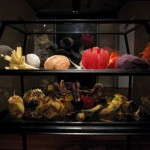 When were you in Blue Mud Bay?
When were you in Blue Mud Bay?
It would have been about this time 2009, just before the wet set in. And then we’ve done an etching project called Djalkiri which means “we are standing in their footsteps”. And it’s a group portfolio of the work of eight of us, including Djambawa. It’s travelling. Will do the rounds of the country in the next couple of years. We had the anthropologist Howard Morphy and also the ethnobiologist from the Darwin Herbarium, Glenn Wightman, accompanying us.
These projects come up when you’ve achieved a certain level of recognition.
Yeah. Another one I have to mention because it’s so exciting, I went as a surrogate New Zealand artist on a NZ Navy ship from Auckland to Tonga along what’s called the Kermadec Trench this May. It was funded by an American philanthropic group who have done lots of marine ecology work. They’re called PEW. They’re apparently an immense philanthropic funding body in the USA. They and some other science and environmental groups are trying to get the whole Kermadec Trench, which is in New Zealand waters, made a marine reserve to protect it from mining and fishing. It was a fantastic trip. We had the NZ minister for conservation on the boat. It was sort of quite political. So that’s all happening now in the lead-up to the NZ elections in late November. We’ve got a show that opens about the same time. That was amazing. Now we’re all making works for that. It was very inspiring.
The Kermadec Trench?
You know the so-called Pacific Rim of Fire, where all the earth’s tectonic plates meet and they’re the earthquake fault lines obviously. For me it’s a bit like that song about your leg bone being connected to your hip bone. Basically, on the western side of the pacific what with poor Christchurch and tragic japan, the Kermadec Trench is one link in that and it’s in New Zealand waters. So it’s a fault line along the Australasian ad Pacific tectonic plates and of course Australia’s on the Australasian plate but New Zealand actually straddles both plates. And then there are other trenches that join it that go up through the eastern seaboard of Japan and down the western side of the USA. The Kermadec Trench is the second deepest trench on the planet. It goes down 10,000 metres. There are more than 30 active volcanoes down there. All sorts of creatures which live far below the level at which daylight can possibly reach have evolved to cope with the toxicity [down there]. Many of those creatures are as yet unknown to science, as they say. Because of the volcanic activity and these underwater vents, there’s actually gold and precious metals deep down there so you can see why the mining industry is circling like sharks wanting to get in there. So PEW thought it would be good to send some artists along. There’s already been some good publicity raised because of our trip, so that’s a good thing. That’s the exciting end of being an artist for me.
What kind of works are you doing from that trip?
Well I shot a bit of video. Our destination point was Tonga at the north eastern end of the Kermadec Trench and I began working with tapa there. Some of the women artists showed me the tapa process. It’s a process of painting with natural dyes and ochres on bark cloth which they make from the bark of the paper mulberry tree which they beat up to form thin sheets. It’s a major art form in the Pacific, from Hawaii all the way through the western Pacific and to New Guinea as well. I’m working on tapa, I’m making 3D objects, or trying to, what with other agendas. Just trying to find enough time for all the ideas.
(Fiona said her next show will be at Roslyn Oxley9 in Sydney in November.)
There’s a parallel project which is for Documenta in Kassel in Germany next year. So that’s my other main agenda at the moment. The Kermadec Trench and Documenta.
What are you doing for Documenta?
I’m doing work that brings together environmental pressures and alludes to politics and the military. And it will be an installation. That’s probably the best way to describe it at present.
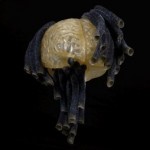 Do you have an assistant?
Do you have an assistant?
No, I do it by myself. It’s very slow. But actually what I get done in an hour or a day or a week seems to be often a pitiful amount. Often it’s very manual work. Because I’m actually making stuff as I go. Because I have a plan in my head, it would be difficult to explain to someone what that idea is. There’s a lot of thinking as I go. There’s not like a set plan that someone could follow on my behalf. And because it is so slow and so laboured, If someone paid me hourly to do the labour, you’d decide there’s better things to do in life. So I just do it all myself. And that’s where you’re driven. Different artists have different ways of working that works well for what they’re trying to achieve. But often I think about it like shooting an arrow at a target and the trajectory of the arrow while it’s travelling towards the target, you can readjust that as you go to try and make sure it hits the target, not off centre. And in a sense you have to have very close control over your work to do that. [Fiona said she works with specialists when she needs something cast or printed and editioned].
I remember interviewing you years ago at the AGNSW when you were knitting objects out of video tape.
Yeah, exactly. Someone said to me once, can you get knitting patterns to knit an arm! I wish, you know? If you could get a knitting pattern you could give it to somebody else. But particularly because you’re trying to knit each unit to be individual, not just carbon copies of each other, that’s a very good example.
Elizabeth Fortescue, September 19, 2011
Callan Park Gallery in Sydney’s Inner West, home to Outsider Art
Jun 19th
Artwriter was happy to write a catalogue essay for a recent exhibition of Outsider Art at the Callan Park Gallery in the grounds of the Sydney College of the Arts. SCA, of course, is part of Sydney University and its Dean is Colin Rhodes, a specialist in the field of Outsider Art and the author of a book on the subject.
The SCA and the Callan Park Gallery are both located in the open parkland of Callan Park, Rozelle, where people walk their dogs and take advantage of one of Sydney’s loveliest open spaces.
The exhibition for which I wrote the catalogue essay was Studio ARTISTS Untitled, and featured the work of five artists from a new collective known as Studio ARTISTS.
Click here to read the essay and see the Studio ARTISTS work. Click here for a link to a good site called Other Academies.
Elizabeth Fortescue, June 19, 2011
